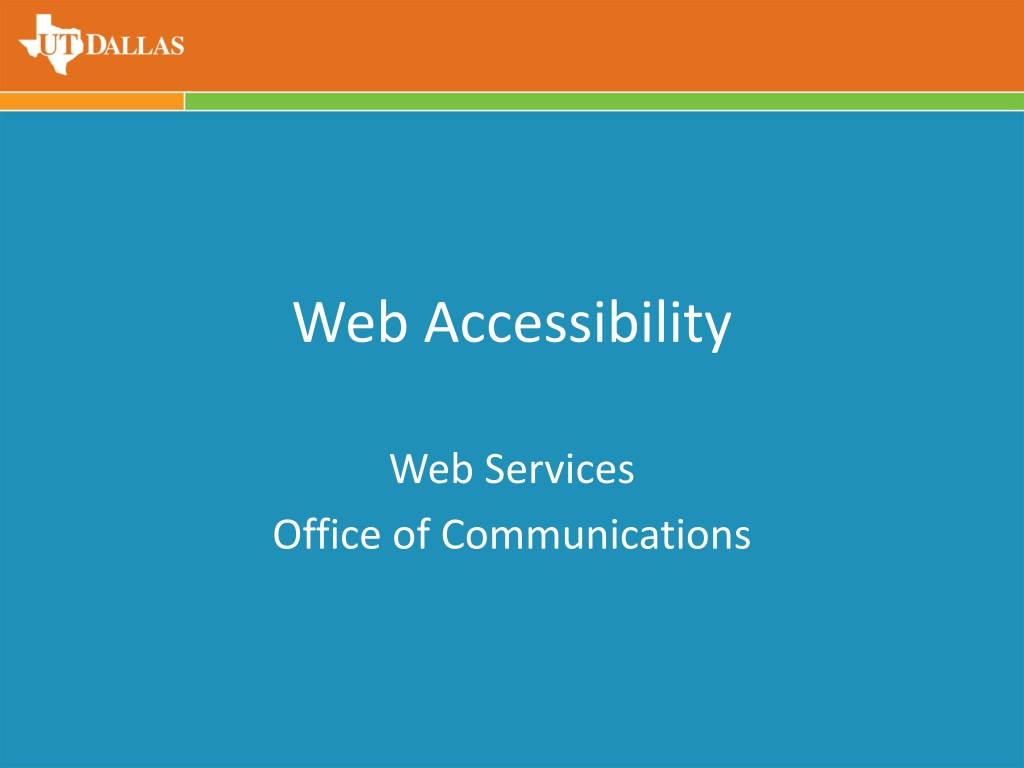Understanding Web Accessibility and Its Importance
Web accessibility ensures that websites are designed to be inclusive and accessible to all users, regardless of their abilities. By removing barriers, web accessibility allows equal access to information and functionality, benefiting not only users but also businesses. Accessibility is vital in various areas like education, employment, government, and healthcare. People with disabilities use alternative methods to navigate the web, emphasizing the need for inclusive design practices. Examples of web accessibility include consistent navigation, readable text, proper formatting, and offering alternative content formats. Implementing web accessibility is crucial for creating an equal and inclusive online environment for everyone.
Download Presentation

Please find below an Image/Link to download the presentation.
The content on the website is provided AS IS for your information and personal use only. It may not be sold, licensed, or shared on other websites without obtaining consent from the author. Download presentation by click this link. If you encounter any issues during the download, it is possible that the publisher has removed the file from their server.
E N D
Presentation Transcript
Web Accessibility Web Services Office of Communications
What is Web accessibility? Web accessibility refers to the inclusive practice of removing barriers that prevent access to websites by people of diverse abilities. When sites are designed, developed and edited correctly, all users would have equal access to information and functionality. The Web is fundamentally designed to work for all people, that include all people no matter what their hardware, software, language, culture, location of physical or mental ability. Access to the Web has become an essential requirement for full participation for the information society.
Benefits of Web accessibility In addition to access to information, there is also a strong business case for accessibility. It overlaps with other best practices such as mobile Web design, usability, design for older users and optimized searches. Case studies have shown that accessible websites have: Better search results Reduced maintenance costs And increased audience reach.
Why is Web accessibility important? The web is becoming an increasingly important resource in many aspects of life in fields such as: Education Employment Government Commerce Health care Recreation It is essential that the Web can be accessible in order to provide equal access and equal opportunity for everyone so they can actively participate in society.
How People with Disabilities Use the Web Alternative keyboards or switches Scanning software Screen magnifiers Screen readers Speech recognition Tabbing through structural elements Text browsers Visual notification Voice browsers
Examples of Web Accessibility Here are some examples of things you can do: Keep navigation the same on each page Have a way for the user to increase/decrease font on pages. Have a high enough contrast between background color and text color. Have alternative text for graphics and videos: Alt text for images and charts Captions and/or transcripts for videos Have links that make sense. Avoid click here as link text. Forms and tables should be properly formatted and labeled with the correct HTML.
Examples of Web Accessibility (cont) Content For scripts, applets and plugins Have an alternative way to access the information Offer information in plain text format when possible; PDFs and Flash files are not easily accessible Do not use different colored text to convey meaning Relevant content for the page Relevant page titles Heading markup Correct HTML markup for relevant content
Evaluating and Testing for Web Accessibility When developing or redesigning a site, evaluate and identify issues early during the process. Try disabling the style sheet, if the content and format is still readable, then the site is accessible. In other words, do not rely on styling to convey core messages. Testing Resources Web Accessibility Evaluation Tools List
Web Accessibility at UT Dallas The University must comply with the Texas administrative code 206.70 Accessibility standard, and therefore all Web pages containing University information that are built, updated or revised must comply with it. TAC 206.70 establishes only a minimum standard for accessibility and Web pages; developers are encouraged to go beyond the minimum whenever possible. UT Dallas is committed to provide accessibility for its website. University Web Services ensures the home and gateway pages meet WCAG 2.0 Level AA Web accessibility standards and promotes best practices in accessibility to UT Dallas Web developers.
Resources Knowbility s Accessibility Training Web Accessibility for Section 508 by Jim Thatcher Web Accessibility Checklist developed by WebAim Web Accessibility Initiative (WAI)


























